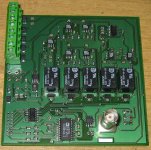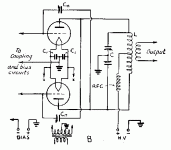hermanv said:Simulators are just tools. They do some things well and others not so well.
Yes. It is just an aid, quite powerful, if properly used. The results depend on person who works with it, his edjucation, knowledge and experience. Race car in hands of primary school student would be rather a weapon than anything else 😉
john curl said:No Scott, you can just BUILD a prototype, and measure it. I have the first JC-2 phono prototype at my office, built into the equivalent of an aluminum baking pan. I also have the original GD modules that became the line amp. To do a matrix would be ridiculous.
I now use the HP32 calculator. The more like a 35, the better. I never liked programming the HP65, either, but I did have some pre-made programs for the 65 that were very useful.
At least your position is made clear, Scott. I hope that mine has been as well.
Please, I was speaking rhetorically. We can’t build prototypes anymore and I do mean that literally, neither can Intel prototype a Pentium. If you wanted to work for Burr Brown (TI) you’d be in the same boat.

scott wurcer said:neither can Intel prototype a Pentium. I
😉 I was about to mention something similar.
Scott, I would like to remind you, in the best way possible, that I worked with computer solving of 50th order matrices back in 1963!. Yes, I would not want to do that by hand, even if it was possible. Please also remember that you challenged my work with ECAP which preceded SPICE, CANCER, CIRCUS, and many other programs, and considered it archaic, yet it solved a 'sparse matrix' on the computer. It just needed a mainframe computer and lots of time. There is nothing wrong with Mathcad, etc. I have tried many examples, and why don't YOU do something useful with it, like solving the distortion equation for the 2N3819 that I put here with Mathcad and put it into something that we can use in our models?
john curl said:Just again, got transient analysis running with your ckt!
That is good, does it look same as in my plots, or is it in different resolution and scale? I mean harmonic analysis, Id current plots will be OK.
Does it work for PSpice, or MC? (There were 2 different ckt files).
john curl said:Please also remember that you challenged my work with ECAP which preceded SPICE, CANCER, CIRCUS,
When? Where? Again a well posed and conditioned problem (easier when the scale is small) typically has a unique solution i. e. these things are all the same and the same as a calculator and pad of paper.

john curl said:I have tried many examples, and why don't YOU do something useful with it, like solving the distortion equation for the 2N3819 that I put here with Mathcad and put it into something that we can use in our models?
You put where? No problem. First I need to finish the ideal diff-pair. I got out my grade school graduation gift from my father, a 1964 CRC, to double check some trig formulas. It still had my name he inscribed with the little strip of gold foil they gave you. Remember when your slide rule didn't have enough digits you could always use the tables?
John I wish you wouldn't act like like I'm attacking you.
I am back!
John,
............your worst nightmare just came true. 😀
Kidding aside ,you and your new best friend PMA have brought some great stuff to the table and not to discount Charles Hansen's contribution. Keep up the good work.
Regards,
Jam
John,
............your worst nightmare just came true. 😀
Kidding aside ,you and your new best friend PMA have brought some great stuff to the table and not to discount Charles Hansen's contribution. Keep up the good work.
Regards,
Jam
Charles Hansen said:
But for those who read the ARRL handbook (as I did as a teenager), look up the section on "neutralization". (I don't know if this information is still in the current editions. You may have to find an old one that still has information on tubes.)
Like everything else, if it were easy, everyone would be doing it. Instead, everyone does the easy thing and uses an output inductor. But doing things the same old way doesn't lead to any advances....
This really happened this afternoon. One of our guys contribs to the ARRL handbook, so I yelled over a few cubes and asked for the oldest article on neutralization that he had. He said "It's just feedback you know".
scott wurcer said:I yelled over a few cubes and asked for the oldest article on neutralization that he had. He said "It's just feedback you know".
That's pretty funny!
But seriously, he must have had a different edition than I had. The article I remember talked about "neutralizing" interelectrode capacitances by injecting an equal and opposite signal. The circuit in question was a push-pull linear transmitter amplifier. With push-pull circuits, it's not too hard to find signals that are equal and opposite...
Again, I don't want to get into an argument on semantics, but this is not really a case of taking a signal from one part of the circuit and "feeding" it "back" to an earlier part of the circuit. In the example I recall in the ARRL handbook, it was taking signals from identical points in each half of the circuit and cross-feeding them to their mirror-image counterparts.
Hello Charles, From recently reading Mr. Pass Zen articles, this sounds much like Nelson Pass Super Symmetry concept.
Peace,
Dave
Peace,
Dave
Charles Hansen said:
The article I remember talked about "neutralizing" interelectrode capacitances by injecting an equal and opposite signal.
AKA "Neutrodyne". Same thing, simply feedback. Although "feedback" could be here just another way to look at a cause-effect relationship.
I'm not sure I follow how the term feedback applies to something at the same stage of amplification. There's no "back" to it.
Grey
Grey
Re: Neutralization
Looks like positive feedback at that.
KSTR said:This circuit, from the 1941 ARRL handbook?
IHMO it would qualify as local voltage feedback.
Looks like positive feedback at that.
Re: Neutralization
I had the same argument at the AES conference in 1991 about equal amplitude subtractive neutralization really being feedback. It is semantic on some level. Inside the loop you have A-A = 0 and there is no term at all that contributes to the closed loop frequency response (in my case).
KSTR said:This circuit, from the 1941 ARRL handbook?
IHMO it would qualify as local voltage feedback.
- Klaus
I had the same argument at the AES conference in 1991 about equal amplitude subtractive neutralization really being feedback. It is semantic on some level. Inside the loop you have A-A = 0 and there is no term at all that contributes to the closed loop frequency response (in my case).
Re: Neutralization
Yes, that is the circuit I was thinking of. As Nelson correctly points out, if you want to think about it as feedback, it would be *positive* feedback.
In this particular case, they are trying to "neutralize" the Miller capacitance that would otherwise limit the bandwidth of the circuit.
This technique is *not* what I use to stabilize my amplifiers when driving a capacitive load. Rather it was a "jumping off" point that inspired a different circuit that worked quite well. (And if one were to see the schematic, *nobody* would claim it was a form of feedback, positive or negative.)
KSTR said:This circuit, from the 1941 ARRL handbook?
IHMO it would qualify as local voltage feedback.
Yes, that is the circuit I was thinking of. As Nelson correctly points out, if you want to think about it as feedback, it would be *positive* feedback.
In this particular case, they are trying to "neutralize" the Miller capacitance that would otherwise limit the bandwidth of the circuit.
This technique is *not* what I use to stabilize my amplifiers when driving a capacitive load. Rather it was a "jumping off" point that inspired a different circuit that worked quite well. (And if one were to see the schematic, *nobody* would claim it was a form of feedback, positive or negative.)
Given that you're talking about oscillation at very high frequencies, I would think that there would be enough phase shift to cancel (that's the point of the circuit, isn't it?) the opposing signal, hence the feedback would be negative at any frequency you'd care about. Somewhat the inverse of amplifier stability problems where feedback that ordinarily would be considered negative becomes positive at some arbitrarily high frequency...and no one bats an eye over the change in feedback nomenclature.
Grey
EDIT: Given that there's little to no audio signal in the high hundred-thousands to MHz range, I'm not sure that it matters if it is "feedback" or not. It's waaaaay beyond anything that even a wide bandwidth person like myself would consider a problem.
And if Charles has taken it in a different direction, then so much the better.
Grey
EDIT: Given that there's little to no audio signal in the high hundred-thousands to MHz range, I'm not sure that it matters if it is "feedback" or not. It's waaaaay beyond anything that even a wide bandwidth person like myself would consider a problem.
And if Charles has taken it in a different direction, then so much the better.
- Status
- Not open for further replies.
- Home
- Amplifiers
- Solid State
- John Curl's Blowtorch preamplifier

